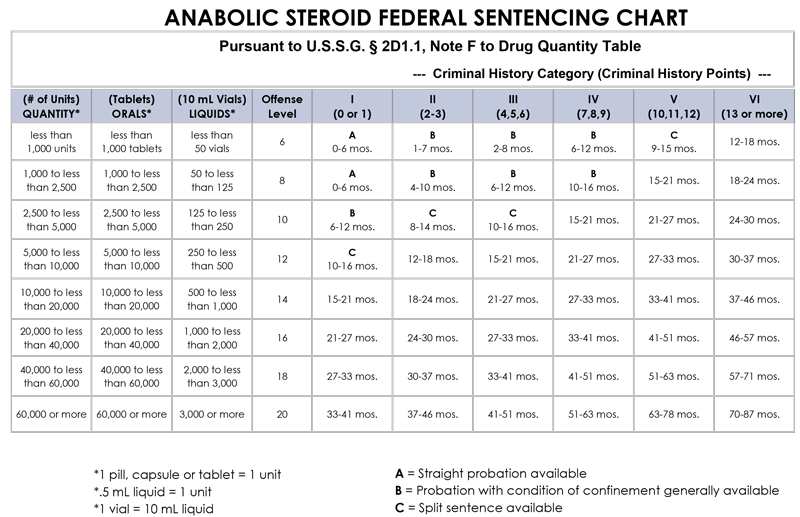Federal Sentencing: Hard Time for Hardbodies?
Federal sentences are tied to the United States Sentencing Guidelines. There’s a chart with “Offense Level” on one axis and “Criminal History Category” on the other. Judges must look at the guidelines in sentencing an offender. In drug cases, the Offense Level is largely driven by the number of drug “units.” One steroid unit is one pill, capsule or tablet, or in the case of liquids, one unit is .5 ml (for powders, 25 mg is one unit). The more units, the greater the Offense Level. The Criminal History Category reflects past criminal behavior (a point-based system). The more prior convictions, the higher the Category (from I to VI) and the higher the prison exposure.
I’ve created a chart specific to anabolic steroids showing how the number of units drives up the range in months of prison exposure, and how it relates to past criminal history. For liquids, I used the familiar measure of 10 mL vials for easy reference. So, for example, trafficking 1,500 pills (1,500 units) and 700 vials of 10 mL (14,000 units) would be 15,500 total units and a base Offense Level 14 (15 to 21 months imprisonment if no priors). While raw powders are not on the chart, some simple math is all that’s needed. There are 40 units in every gram of powder. So, for example, one kilogram of raw powder is 40,000 units (1,000 grams per kilo) which would be Offense Level 18.
- Anabolic Steroid Federal Sentencing Chart
The number of units and criminal history, however, provide only the starting point in federal steroid trafficking sentences. Other factors adjust the guideline level upward or downward. Among the factors which can increase the level are having an aggravating role in the offense (such as leading others in the crime), laundering the proceeds, possessing firearms, mass marketing over the Internet, and importing the drugs. Some adjustments are unique to steroid cases, such as distributing to an “athlete.” Other factors can reduce the level, such as accepting responsibility via a timely guilty plea. The sentencing judge must determine the final adjusted Offense Level before imposing sentence. However, great lawyering can often achieve a sentence substantially below the applicable guideline range. The sentencing court is permitted to take into account the history and characteristics of the defendant when considering sentence and when those factors are positive, courts have held that a sentence outside the guideline range may be appropriate. At the end of the day, a sentence must be “sufficient” but not greater than necessary.
Even experienced federal criminal practitioners often have little or no experience in steroid sentencing. If you or anyone you know is charged with a steroid crime, be sure to hire a lawyer who has a clue. If you’re in the game, feel free to keep my number handy. I’m at 516-294-0300 and I’m here to help.
______________________________
[© Rick Collins, 2018. All rights reserved. For informational purposes only, not to be construed as legal or medical advice.]





